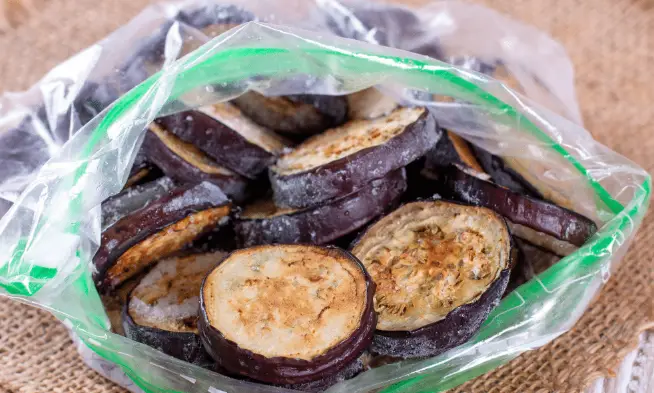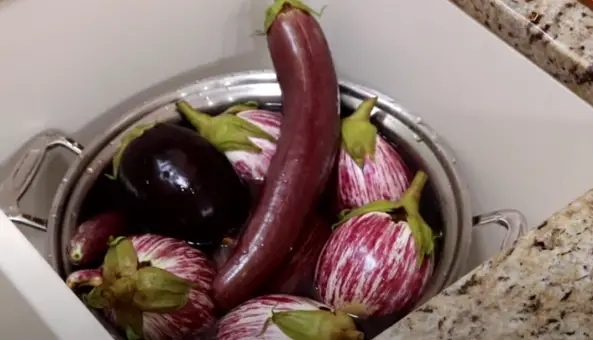Short answer: Yes, you can freeze sliced eggplant. It’s typically recommended to blanch or cook the slices before freezing to maintain texture and flavor during storage.
Eggplant is a versatile vegetable loved for its rich, earthy flavor, you might wonder if it’s possible to freeze it for long-term storage. The Freezing not only extends the vegetable’s shelf life but also allows you to have this nutrient-rich produce on hand for your future culinary endeavors. Whether you’re planning to make eggplant parmesan, moussaka, or stir-fry, freezing sliced eggplant can be a handy and efficient solution to reduce waste and keep this versatile ingredient within reach.
Can You Freeze Sliced Eggplant?

Yes, you can freeze sliced eggplant. Freezing is an excellent way to preserve eggplant for later use. By blanching the eggplant slices prior to freezing, you can maintain their color, texture, and flavor. Once frozen, these slices can be used in a variety of dishes such as eggplant parmesan, stir-fries, or stews, making it a convenient option for meal preparation.
How To Freeze Sliced Eggplant?
Method 1: Freezing Blanched Eggplant Chunks

Step 1: Wash your eggplant thoroughly and peel it.

Step 2: Cut the eggplant into small pieces.

step 3: Bring a large pot of water to a boil. Add lemon juice to the water (1/2 cup of lemon juice to 1 gallon of water or adjust the ratio based on your needs).
Step 4: Drop the eggplant pieces into the boiling lemon water and let them blanch for up to four minutes.
Step 5: Using a slotted spoon, immediately transfer the blanched eggplant pieces into an ice water bath to cool quickly.
Step 6: Drain the eggplant pieces well, then pack them into an airtight freezer container.
Step 7: Place the container in the freezer. The eggplant should keep for about six to eight months.
Method 2: Freezing Roasted Eggplant
Step 1: Wash the eggplant and leave it whole.
Step 2: Poke some holes in it with a fork to allow steam to escape.
Step 3: Place the eggplant on a baking tray and roast it in a 400 degrees Fahrenheit oven until it collapses. The time will depend on the size of the eggplant.
Step 4: Once cooled enough to handle, cut the eggplant open and scoop out the pulp.
Step 5: Put the pulp in an airtight container and place it in your freezer. This is excellent for use in soups, sauces, or dips.
Method 3: Freezing Eggplant Slices For Frying
Step 1: Wash and slice the eggplant.
Step 2: Blanch the slices briefly in lemon water (as in Method 1).
Step 3: Cool them in a bowl of cold water, then drain and dry them well.
Step 4: Batter the slices as if you were going to fry them immediately.
Step 5: Lay the slices on a baking tray lined with parchment paper.
Step 6: Freeze them until solid (around an hour or two).
Step 7: Transfer the frozen slices into a rigid freezer container. Use layers of wax paper to separate layers of eggplant slices, preventing them from freezing into one big mass.
Method 4: Freezing Eggplant Casserole

Step 1: Prepare your eggplant casserole or lasagna as usual.
Step 2: Allow the casserole to cool.
Step 3: Divide the casserole into single-serving portions.
Step 4: Put each portion in a rigid, airtight freezer container.
Step 5: Place the containers in your freezer. These will keep for about six to eight months.
Method 5:
Step 1: Rinse about nine eggplants (of oblong, oval shape) and soak them in a mixture of vinegar and water. This helps kill any bacteria or bugs still on the vegetable.
Step 2: Slice the eggplants. If you want to use them for eggplant parmesan or similar dishes, slice them between half an inch and an inch thick.
Step 3: Bake the eggplant slices in the oven. This is necessary because eggplant has a high water content, so it needs to be cooked before freezing. You’ll see moisture steaming off the rounds as they cook.
Step 4: If you want to use the eggplant in stews or dips where you need it soft, you can also bake it whole. Just trim off the ends and poke the skin to let the moisture out. When you see the skin collapse (approximately after 30 minutes in the oven, depending on the size), it’s ready to be taken out.
Step 5: Allow the baked eggplants to cool on a rack.
Step 6: If you’ve baked the eggplant in slices, wrap each slice in wax paper as soon as it’s cool enough to handle.
Step 7: Place the wrapped slices into freezer bags.
Step 8: For whole baked eggplant, scrape out the soft flesh and put it into a container suitable for freezing.
Step 9: Put the containers and/or bags in the freezer.
Method 6:
Step 1: Gather your ingredients: eight small eggplants or one large eggplant, 1 teaspoon of salt, 3 tablespoons of oil, and a dish with some water.
Step 2: Add the salt to the water and mix it until the salt dissolves.
Step 3: Cut the eggplants into small pieces or chunks and add them to the dish with the salted water. The size of the chunks will depend on how you plan to use them in your recipes.
Step 4: Once all the eggplants are cut and in the salt water, mix them around and let them soak for 5 minutes.
Step 5: After soaking, drain the water from the eggplants and transfer them to a microwave-safe dish.
Step 6: Add oil to the eggplants in the dish, mixing well to coat the eggplant pieces.
Step 7: Cover the dish with plastic wrap and microwave it for 3 minutes.
Step 8: After the initial 3 minutes, carefully remove the dish from the microwave, unwrap, and mix the eggplant. Cover the dish again with the plastic wrap and microwave for an additional 2 minutes.
Step 9: Take the dish out of the microwave, mix the eggplant again, cover it back, and let it cool down completely for about 30 minutes.
Step 10: Once the eggplants have cooled down, transfer them into snap lock bags or freezer bags.
Step 11: Store these bags in the freezer. The eggplant should be good for six to eight months.
Thawing The Frozen Eggplants
Step 1: Remove the eggplant from the freezer and place it in the refrigerator. It’s recommended to place the frozen eggplant in a bowl or on a plate to catch any condensation or drips as it thaws.
Step 2: Allow the eggplant to thaw in the refrigerator for several hours or overnight. The exact time needed will depend on the size and thickness of the eggplant pieces.
Step 3: Once the eggplant has thawed, it should be used immediately to ensure the best quality and taste. It’s important not to refreeze thawed eggplant as this can significantly impact its texture and flavor.
FAQs
What can I do with an overripe eggplant?
Overripe eggplant can be used in a variety of ways. You could make baba ganoush, a Mediterranean dip, by roasting the eggplant, peeling it, and blending it with tahini, garlic, lemon juice, and olive oil. You could also use overripe eggplant in a stir fry, soup, or stew where its texture won’t be as noticeable. Please note that if the eggplant is extremely overripe and has a bad smell or visible mold, it should be discarded.
What is a good use for leftover eggplant skin?
Eggplant skin is rich in nutrients and fiber and can be incorporated into many recipes to add a bit of texture. You can roast them in the oven with a bit of olive oil, salt, and pepper until they’re crispy and use as a garnish. Alternatively, you could use them in stocks or broths to add a depth of flavor. However, if the skin is very tough or bitter, you might want to discard it.
What can I make with large eggplants?
Large eggplants are perfect for dishes where the eggplant needs to be stuffed or sliced into large pieces. You can make stuffed eggplant by hollowing out the eggplant and stuffing it with a mix of meat, rice, vegetables, and spices before baking. Moussaka, a Greek dish that layers eggplant with meat and sauce, is another excellent use for large eggplants. Large slices can also be grilled or roasted as a main dish or side.
Should aubergine be stored in a fridge?
Aubergine, also known as eggplant, is best stored at room temperature away from direct sunlight, ideally in a cool, dark place. Refrigeration can affect the texture and flavor of the aubergine, so it’s usually not recommended unless the aubergine is cut or the room temperature is very warm.
What are some substitutes for eggplant in cooking?
The best substitute for eggplant depends on the specific recipe and its flavors. Zucchini or squash can be used in many dishes for a similar texture and mild flavor. Mushrooms can also be used as a substitute, especially in dishes where a meaty texture is desirable. For recipes that require a similar flavor profile, green bell peppers or tomatoes can work well. Keep in mind, these substitutes might not have the exact same texture or taste as eggplant, but can still work well in many recipes.
Conclusion
Yes, it’s entirely possible to freeze sliced eggplant, and doing so can help maintain its freshness for an extended period. Freezing offers a convenient way to store surplus eggplant, enabling you to enjoy this versatile vegetable out of season or whenever you wish. Properly frozen eggplant slices can be stored in the freezer for several months. When you’re ready to use the frozen eggplant, thaw it in the refrigerator before incorporating it into your desired recipes. Keep in mind that frozen eggplant may have a slightly softer texture upon thawing, but it can still be used in various dishes such as stews, casseroles, or stir-fries.

John Hebdon is a food enthusiast, passionate chef, and author of various articles and blog posts related to food and cooking. With a deep love for all things culinary, John’s blog serves as a platform to share his extensive kitchen experiences with a broader audience.
In addition to his culinary expertise, John has a flair for writing and a natural ability to share his passion for food with others. His articles and blog posts are informative, engaging, and packed with practical tips for readers of all skill levels.
As a food enthusiast and writer, John is always on the lookout for new and exciting culinary experiences. Whether it’s trying out a new restaurant, experimenting with a new recipe, or simply sharing a favorite dish with friends and family, John is always eager to explore and share the world of food with others.






